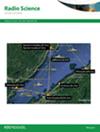与太阳终结者有关的高纬度偏离大圆传播
IF 1.6
4区 地球科学
Q3 ASTRONOMY & ASTROPHYSICS
引用次数: 0
摘要
与太阳终结者有关的大规模电离层梯度会使高频(HF)无线电波在早晨和傍晚偏离大圆路径,从而对依赖 HF 无线电波传播的技术产生负面影响。例如,科学和军用超视距雷达(OTHR)使用的地理定位算法通常假定是在大圆上传播的,因此横向偏离大圆路径会导致定位错误。在这项研究中,通过三维数值射线轨迹模拟了无线电波的传播,该射线轨迹是在一天和一年中的不同时间初始化的经验高纬度电离层模型,以探索和量化与太阳终结者有关的高纬度偏离大圆传播。对这些模拟的分析表明,太阳终结者造成的大尺度东西电离层梯度在日出和日落时会导致向北传播路径的横向偏差超过 20°,这取决于无线电波频率,尽管接收信号功率的最大部分往往会出现 5°的最大偏差。对传播方向与偏转关系的研究表明,与太阳终结点平行的传播路径往往偏转最大。由于高纬度地区的太阳终结者在冬季和夏季与北方成一定角度,因此在这些季节的日出和日落时分,向北偏西或偏东的传播路径会比向北的传播路径发生更大的偏转。本文讨论了这些昼夜偏转对 OTHR 和科学雷达运行的影响,以及减轻这些影响的可能策略。本文章由计算机程序翻译,如有差异,请以英文原文为准。
High-latitude off-great circle propagation associated with the solar terminator
Large-scale ionospheric gradients associated with the solar terminator can deflect high frequency (HF) radio waves to off-great circle paths during the morning and evening, negatively impacting technologies reliant on HF radio wave propagation. For example, geolocation algorithms used by scientific and military over-the-horizon radars (OTHRs) generally assume on-great circle propagation, and thus lateral deviations from the great-circle path can lead to positioning errors. In this study, radio wave propagation is simulated via 3D numerical ray traces though an empirical, high-latitude model ionosphere initialized for a variety of times of the day and year to explore and quantify high-latitude off-great circle propagation associated with the solar terminator. Analysis of these simulations show large scale east-west ionospheric gradients due to the solar terminator can cause lateral deviations in north-directed propagation paths exceeding 20° at sunrise and sunset depending on radio wave frequency, though the largest portion of received signal power tends to experience maximum deflections of 5°. An exploration of the dependence of propagation direction on deflection shows that propagation paths parallel to the solar terminator tend to experience the largest deflections. Since the solar terminator at high latitudes is at an angle with respect to north in the winter and summer, propagation paths oriented west or east of north can experience larger deflections than north oriented paths at sunrise and sunset during these times of year. Impacts of these diurnal deflections on the operation of OTHR and scientific radar are discussed, as well as possible strategies for mitigating them.
求助全文
通过发布文献求助,成功后即可免费获取论文全文。
去求助
来源期刊

Radio Science
工程技术-地球化学与地球物理
CiteScore
3.30
自引率
12.50%
发文量
112
审稿时长
1 months
期刊介绍:
Radio Science (RDS) publishes original scientific contributions on radio-frequency electromagnetic-propagation and its applications. Contributions covering measurement, modelling, prediction and forecasting techniques pertinent to fields and waves - including antennas, signals and systems, the terrestrial and space environment and radio propagation problems in radio astronomy - are welcome. Contributions may address propagation through, interaction with, and remote sensing of structures, geophysical media, plasmas, and materials, as well as the application of radio frequency electromagnetic techniques to remote sensing of the Earth and other bodies in the solar system.
 求助内容:
求助内容: 应助结果提醒方式:
应助结果提醒方式:


